Cummins ISF3.8 diesel four-stroke, four-cylinder, in-line, sixteen-valve, liquid-cooled, turbocharged engine
The engine is equipped with an electronic fuel supply system.
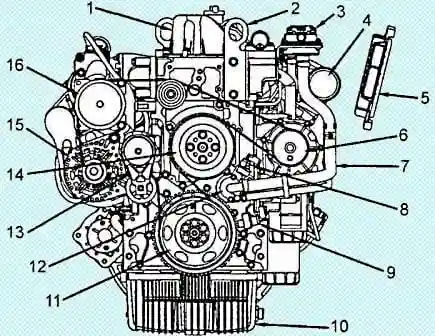
Engines ISF3.8 CM2220, ISF3.8 CM2220 AN, ISF3.8 CM2220 LAN with a closed crankcase ventilation system - front view: 1 - cylinder head cover, 2 - engine front lifting bracket, 3 - closed crankcase ventilation valve , 4 - air inlet, 5 - electronic control unit (installed with engine), 6 - water pump pulley, 7 - crankcase ventilation hose and engine oil drain hose, 8 - camshaft position sensor, 9 - crankshaft position sensor , 10 - oil pan, 11 - crankshaft pulley, 12 - cover, 13 - accessory drive belt tensioner, 14 - cooling fan pulley, 15 - alternator, 16 - air conditioning compressor
In figure 1, ISF3.8 CM2220, ISF3.8 CM2220 AN, ISF3.8 CM2220 LAN engines with a closed crankcase ventilation system - front view
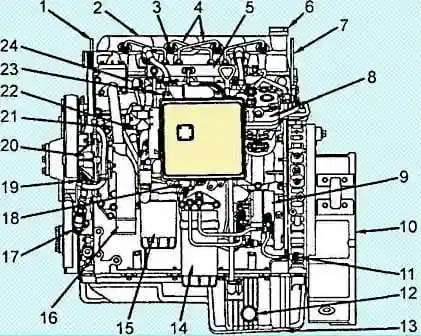
Engines ISF3.8 CM2220, ISF3.8 CM2220 AN, ISF3.8 CM2220 LAN - left side view: 1 - engine front lifting bracket, 2 - cylinder head cover, 3 - injector, 4 - high pressure fuel pipe, 5 - fuel accumulator, 6 - oil filler cap, 7 - rear engine lift bracket, 8 - air conditioning compressor, 9 - injection pump, 10 - flywheel housing, 11 - fuel supply, 12 - engine oil heater, 13 - oil pan drain plug, 14 - fuel filter, 15 - oil filter, 16 - coolant inlet, 17 - crankshaft position sensor, 18 - atmospheric pressure sensor, 19 - camshaft position sensor, 20 - coolant pump, 21 - coolant bypass pipe, 22 - engine oil pressure sensor (behind the ECU on the oil cooler), 23 - boost pressure sensor and intake air temperature sensor assembly, 24 - coolant temperature sensor
In figure 2, ISF3.8 CM2220, ISF3.8 CM2220 AN, ISF3.8 CM2220 LAN engines - left view
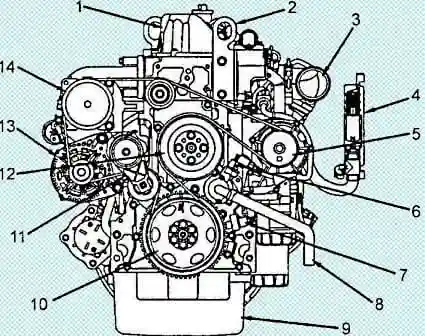
Engines ISF3.8 CM2220, ISF3.8 CM2220 AN, ISF3.8 CM2220 LAN with an open crankcase ventilation system - front view: 1 cylinder head cover, 2 - engine front lifting bracket, 3 - air inlet, 4 electronic control unit (installed with engine), 5 - coolant pump pulley, 6 - camshaft position sensor, 7 - crankshaft position sensor, 8 - crankcase ventilation pipe, 9 - oil pan, 10 - crankshaft pulley, 11 - tensioner attachment drive belt, 12 - cooling fan pulley, 13 - generator, 14 - air conditioning compressor
In Figure 3, ISF3.8 CM2220, ISFЗ.8 CM2220 AN, ISF3.8 CM2220 LAN engines with an open crankcase ventilation system - front view
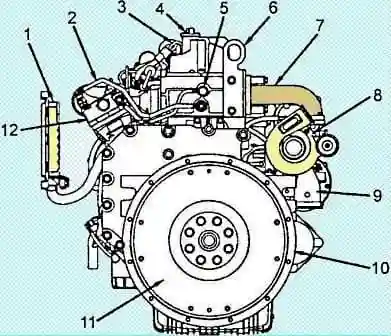
Engines ISF3.8 CM2220, ISF3.8 CM2220 AN, ISF3.8 CM2220 LAN - rear view: 1 - electronic control unit (installed on the engine), 2 - air compressor lines, 3 - high pressure fuel pipes, 4 - oil filler cap, 5 - fuel return line, 6 - engine rear lift bracket, 7 - exhaust manifold, 8 - turbocharger, 9 - turbocharger outlet, 10 - flywheel housing, 11 - flywheel, 12 - air compressor
In figure 4, ISF3.8 CM2220, ISF3.8 CM2220 AN, ISF3.8 CM2220 LAN engines - rear view
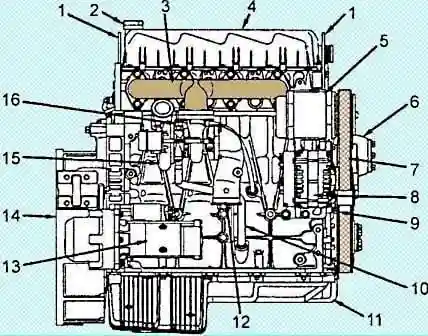
Motors ISF3.8 CM2220, ISF3.8 CM2220 AN, ISF3.8 CM2220 LAN - right side view: 1 - lifting bracketn engine, 2 - oil filler cap, 3 - exhaust manifold, 4 - cylinder head cover, 5 - air conditioning compressor, 6 - fan hub, 7 - accessory drive belt, 8 - generator, 9 - gear, 10 - tube oil return from the turbocharger, 11 - oil pan, 12 - exhaust pipe, 13 - starter, 14 - flywheel housing, 15 - turbocharger, 16 - oil supply pipe to the turbocharger
In figure 5, ISF3.8 CM2220, ISF3.8 CM2220 AN, ISF3.8 CM2220 LAN engines - right side view
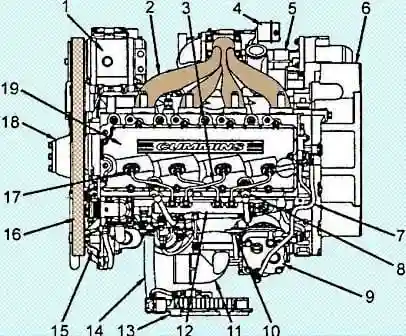
Engines ISF3.8 CM2220, ISF3.8 CM2220 AN, ISF3.8 CM2220 LAN - top view: 1 - air conditioning compressor, 2 - exhaust manifold, 3 - high pressure fuel pipes, 4 - turbocharger bypass valve actuator, 5 - starter, 6 - flywheel housing, 7 - air compressor lines, 8 - fuel accumulator pressure sensor, 9 - air compressor, 10 - oil dipstick, 11 - air inlet, 12 - fuel rail, 13 - electronic control unit, 14 - engine wiring, 15 - water pump, 16 - accessory drive belt, 17 - injector, 18 - fan hub, 19 - cylinder head cover
In Figure 6, ISF3.8 CM2220, ISFЗ.8 CM2220 AN, ISF3.8 CM2220 LAN engines - top view
Engine specifications
Note: The given power and torque values are indicative and may vary significantly depending on the specific model, gearbox, year of manufacture, computer software version and measurement method.
The cylinder block is made of gray cast iron.
The cylinders are bored in the block itself.
Coolant channels are bored between the cylinders.

The cylinder block has lugs and holes for attaching parts and assemblies.
Five main bearing supports are made at the bottom of the cylinder block.
The main bearing caps are attached to the block with two bolts each.
The covers are processed together with the block, they cannot be interchanged.
The cover of the fourth bearing is machined for the installation of liners with shoulders to limit the axial movement of the crankshaft.
Serial numbers are embossed on each cover.
An oil pump is attached to the front end of the block.

The oil pump housing is made of aluminum alloy.
The front crankshaft oil seal is pressed into the oil pump housing.
The flywheel housing is attached to the rear end of the block, Figure 1, to which the clutch housing is attached.
The flywheel housing is made of cast iron and the clutch housing is made of aluminum alloy.
The cylinder head is attached to the top of the block, and a pallet made of plastic is attached to the bottom.
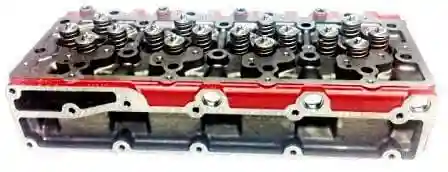
The cylinder head (cylinder head) is made of gray cast iron according to the transverse cylinder purge pattern.
A metal-reinforced, non-shrink gasket is installed between the cylinder block and the head.
Inlet and outlet valves made of heat-resistant steel are installed in the head.
Chrome-plated valve stems.
The valves are equipped with one spring each and are fixed through the plate with two crackers.
The springs are made of transformer steel.
The valve guides are made directly in the cylinder head and do not have bushings, therefore, when the valve guides are worn, the cylinder head is replaced.

The camshaft is made of cast iron and has five bearing journals, and two cams per cylinder.
The camshaft is installed in the cylinder block.
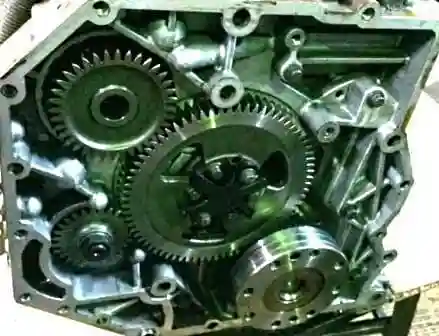
The camshaft is driven through a gear that meshes with the crankshaft gear (Fig. 7).
Camshaft lobes act on tappets.
Push rods actuate valves through rocker arms.
The rocker arms are bolted to the block head.
The clearances in the valve actuator are adjusted using bolts with locknuts screwed into the rocker.
There are no combustion chambers in the lower part of the head, as they are made in the piston bottoms.
The top of the cylinder head is closed with a plastic cap.
The valve seats are installed with an interference fit in the cylinder head.
Crankshaftsteel five-bearing, rotates in main bearings with thin-walled steel liners with an anti-friction layer.
The lower inserts are bimetallic and the upper inserts are trimetallic.
Only the top bearings have oil drain holes.
A hexagon is made on the front toe of the crankshaft to drive the oil pump.
A gear is made on the rear toe of the crankshaft to drive the fuel pump and camshaft.
The axial displacement of the crankshaft is fixed by the shoulders of the upper shell of the fourth main bearing.
The groove on the rear neck of the camshaft is made to install a thrust plate into it in order to fix the shaft from axial movement.
At the rear end of the camshaft, a shank with an internal thread is made to install the sprocket of its drive.
The camshaft is rotated by a gear that meshes with the crankshaft gear.
The entire timing gear is assembled in the timing gear housing.
Pistons are made of aluminum alloy.
A combustion chamber is made in the bottoms of the pistons.
In order to correctly install the piston in the cylinder, an arrow is marked on the upper surface.
The piston is installed so that the arrow is facing the front of the engine.
There are three rings on the pistons. Two compression rings and one oil scraper ring.
Trapezoid top ring.
The second compression ring has a groove. The ring must be installed with this groove down.
The oil scraper ring consists of a cast ring and an expander.
The piston is attached to the connecting rod with a floating piston pin.
The pin is kept from axial movement by retaining rings in the piston bosses.
To cool the pistons, nozzles are installed on the lower part of the cylinder block, which are connected to the oil line.
Oil from the nozzles is sprayed onto the piston skirts.
Steel forged connecting rods.
A tin bronze bushing is pressed into the upper end of the connecting rod.
The connecting rod cap is attached with two bolts.
Cylinder numbers are embossed on the connecting rod caps. The connecting rod caps and the connecting rods themselves are made as one piece.
Therefore, you can not change places. Connecting rod bearings are inserted into the lower head of the connecting rod.
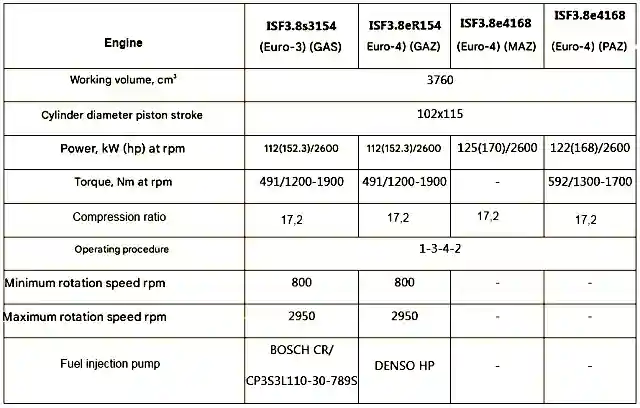
Flywheel cast iron, with steel gear. It is attached to the crankshaft with eight bolts.
In the central part, the thrust bearing of the input shaft of the gearbox is pressed in.
The engine lubrication system is combined: the most loaded parts are lubricated under pressure, while the rest are lubricated either by directed spraying or spraying of oil flowing from the gaps between mating parts.
The pressure in the lubrication system is generated by an oil pump installed in the front cover of the cylinder block and driven from the front end of the crankshaft.
The pump sucks oil from the engine oil sump through the oil receiver and delivers it through the oil filter to the main oil line.
The channels for supplying oil to the main bearings of the crankshaft depart from the main line.
In the beds of the main bearings, nozzles are installed through which oil is sprayed onto the cylinder walls and piston bottoms.
Oil is supplied to the connecting rod bearings through channels made in the body of the crankshaft.
A channel for supplying oil to the camshaft bearings departs from the main oil line.
Part of the oil is discharged through a hose to the turbocharger, after which it returns back to the crankcase.
Excess oil is drained from the head of the block into the oil sump through the drainage channels.





